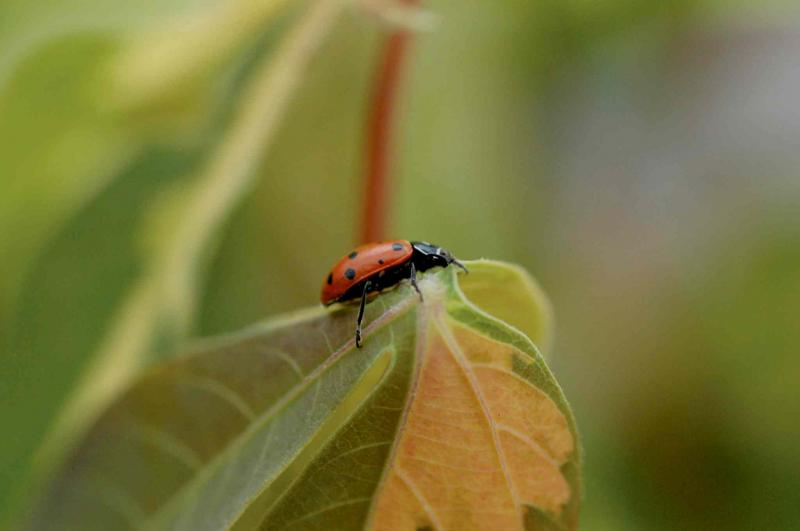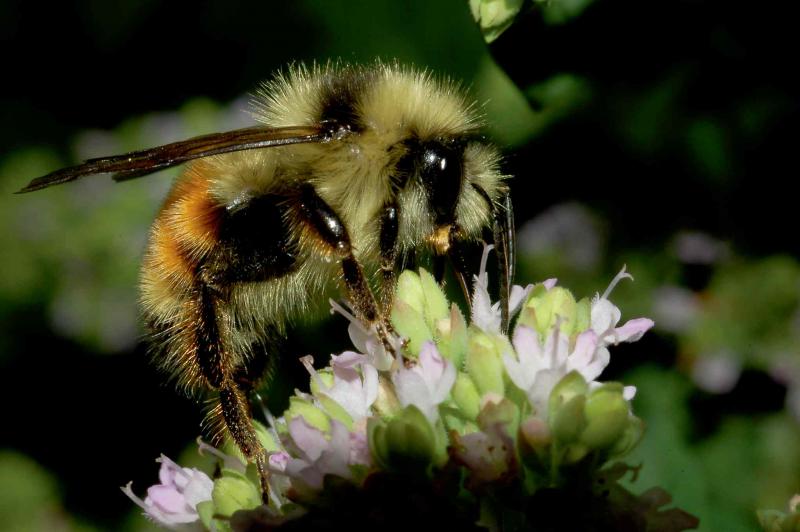
Last summer, when I discovered the red lily beetle in my garden for the first time, I soon realized I wasn't one of those gardeners with a stomach for picking them off, one by one. Perhaps if this scarlet red, hard- shelled beetle with its pitch- black underside travelled alone the task wouldn't be so disgusting but unfortunately, a typical infestation can number in the hundreds.
The advice from lily experts seems simple enough: Pick off the beetles, drop them into a sealed container and repeat. Every day, several times a day. It seems an innocuous enough approach, but unfortunately it didn't work in time to save my lilies from being devoured.
At about the same time, the rose sawfly descended upon my garden. Barely visible to the eye thanks to a minute size and light green colour, it lacks the audaciousness of the red lily beetle, preferring to go unnoticed by munching voraciously with saw-like precision on the undersides of leaves until they are skeletonized, with only the veins remaining.
Even if I was inclined toward having a well-stocked supply of chemical solutions for pest control, which I am not, both of these particular pest problems are best controlled by simple non-chemical remedies -- such as early monitoring of pest populations -- before significant damage is done.
Proper identification of the pest is important. Most insects play an important role in the garden, either as pollinators or harmless predators that eat other insects.
In a nature-friendly garden that takes an integrated pest management (IPM) approach, strategies for cultural methods of pest control begin at the time of plant selection. Healthy plants that are planted in areas of the garden where they receive appropriate light and moisture conditions can withstand pest attacks better than plants that are stressed by damp conditions or overcrowding, for example. Removing and destroying dead, diseased or dying material helps to prevent the development of diseases such as fungi and bacteria and minimizes areas that can harbour multiplying pest populations capable of the most destruction.
Gardeners will always face some degree of damage from pests in the garden. Understanding the pest's life cycle allows for control measures to be applied at the proper developmental stage of the pest. If your tactics in the war against pests consist more of a chemical approach than that of IPM, be prepared this spring for new regulations that came into effect on Jan. 1. Full details are available at web2.gov.mb.ca/laws/regs.
Ken Land, co-owner of St. Mary's Nursery, is securing his pesticide products in a locked cabinet as required by the Non-Essential Pesticide Use Regulation under the Environment Act. A sign instructs customers to please ask for assistance. The new legislation requires retailers to inquire about purchases and provide information to their customers about the specific circumstances under which a pesticide that falls under the regulations must be used.
While the regulations apply mainly to lawns and associated areas such as driveways, sidewalks and patios, there will still be the ability to use prescribed pesticide products to destroy noxious weeds, such as Canada thistle or poisonous plants, such as poison ivy.
Not everyone is going to readily embrace the new regulations. Some have already stocked up in preparation and others have resorted to crossing into jurisdictions where certain chemicals are more widely available so they can be ready to surreptitiously apply their favourite chemical at the first sign of a dandelion.
What concerns the average gardener even more, says Land, is if they have a pest problem that is destroying their plants. That concern increases for the homeowner who has relied on chemical control measures that have worked in the past and are now not as accessible in the interests of reducing pesticide exposure.
What if a homeowner has an existing supply of banned chemical options? If products have been properly stored in a locked, sealed area with appropriate climate controls, they can last for many years.
Taz Stuart, entomologist and director of technical operations for Poulin's Pest Control, is a vocal proponent of IPM as a proactive approach to pest problems. Stuart is gearing up for the many calls he expects to receive from homeowners who want to know what to do about disposal of their supply of products that come under the new regulations.
Stuart says containers with unused pesticides can be safely disposed through the City of Winnipeg's household hazardous waste disposal program. Contact Miller Environmental Corporation (1803 Hekla Ave.) at 204-925-9600. In rural areas, contact Green Manitoba at greenmanitoba.ca or call toll-free 1-866-460-3118.
Stuart recommends homeowners who hire licensed applicators always ask for proof of certification, including a current IPM license. Changing one's ideology can be a slow process, said Stuart, who emphasized chemical options should be the last resort in the garden.
Waging war against pests with more environment-friendly tactics finds many innovative solutions. Could biopesticides be one answer to effectively managing pests? Ken Land says St. Mary's Nursery carries ladybugs and praying mantises and sells them as egg cases. Hatching is triggered by warm weather. The praying mantis has a voracious appetite for pests such as aphids, although its use is designed for a single season since mantises will not survive our winter.
Land will also be selling leaf-cutter bees and mason bees as well as mason bee houses. While leaf-cutter bees will make circular saw-blade cuts in the leaves of roses and other plants such as lilacs, they are also important as pollinators. Deter them from making their home in the exposed pith of pruned rose canes with a bit of sealing wax.
Problem pests such as aphids and slugs or diseases such as tomato blight, mildew or leaf spot on roses do not recognize international boundaries and migrate freely.
Gord and Betty Sanguin garden in the Riverview area. Proponents of a homeopathic approach to managing their own health, they are keen to experiment with homeopathy for plants, an intriguing alternative premise that is meeting with some extraordinary success in a growing number of European gardens.
Based on the book Homeopathy for Plants by Christiane Maute (Narayana Publishers, 2011), the idea to treat plants homeopathically began in a small homeopathy clinic where she works that also serves as a publishing house in Kandern, a German town situated at the edge of the Black Forest.
Maute, a dedicated homeopath, was motivated by the desire to reduce the need for chemical pesticides in her own garden in her hometown of Friedrichshafen. Experimenting on a physically damaged delphinium with Arnica 200C, a homeopathic remedy she normally prescribed for patients who suffered shock or injury as a result of a blow or fall, Maute was amazed by the plant's positive response and subsequent recovery. When the leaves of a favourite cherry tree on her terrace began to exhibit signs of disease, Maute decided to experiment by watering the trunk and soil with a Thuja mixture normally prescribed for people experiencing fungal infections. The tree began producing healthy, new growth.
Assisted by fellow homeopaths such as Jurgen Sigward, other experiments followed that caught the interest of local media and the public. In a recent phone interview, Sigward described the reaction to a controlled experiment involving two lettuce plots, one of which was left untreated and the other treated homeopathically with Helix tosta, made from the shell of dead snails. Guess which of the lettuce plots was consumed by slugs? With photographic evidence of the untreated plants eaten down to the stems, Sigward says their small clinic was flooded with hundreds of orders from different villages throughout Bavaria.
An online forum was started so gardeners could share their experiences, whether successes or failures.
Homeopathy for plants, involving as it does dosages and potencies of numerous remedies emanating from plant or mineral sources (albeit in highly diluted tinctures), may or may not be the future of pest and disease control in your garden. Maute, though, shared with me, "One of my main hopes is that our beautiful world will perhaps manage with far fewer chemical pesticides in the future. This will be kinder to both the environment and our bank balances."
Notice: Plan to attend the Green Show, Manitoba's premier green industry conference and trade show, presented by Landscape Manitoba. Feb. 9-10 at the Victoria Inn Hotel and Conference Centre. Visit www.manitobagreenshow.com for more details and to pre-register for seminars.
colleenizacharias@gmail.com




